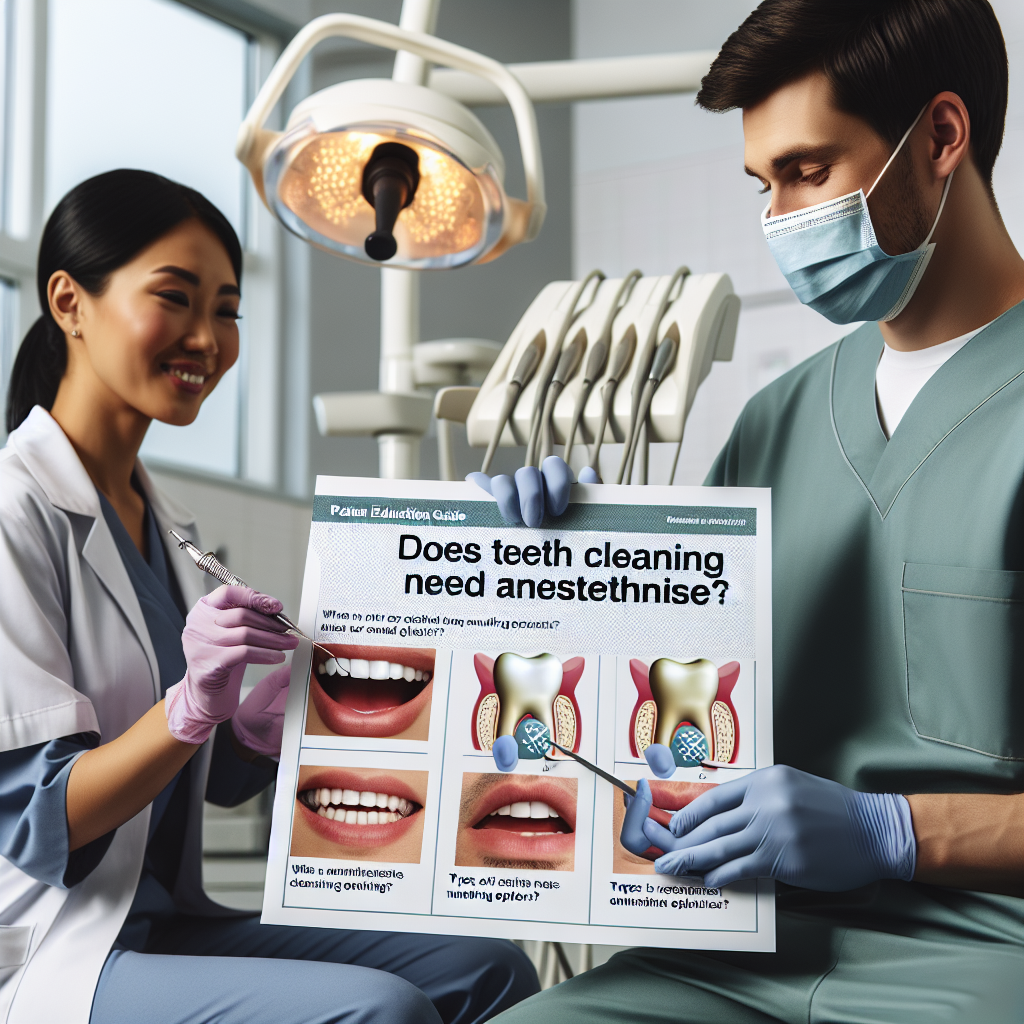The Ultimate Guide to Anesthesia Options for Dental Cleanings5 min read

Getting your teeth cleaned is essential for maintaining optimal oral health, but many patients have concerns about the use of anesthesia during the procedure. Understanding when anesthesia is necessary and the different types of numbing options available can help alleviate anxiety and ensure a comfortable dental experience. This comprehensive guide will explain the factors that determine anesthesia choice for dental cleanings and provide insights into the various sedation methods used in dentistry.
When is Anesthesia Needed for Dental Cleanings?
The need for anesthesia during a dental cleaning depends on several factors, including the patient’s overall health, sensitivity level, and the extent of the cleaning required. In most cases, routine dental cleanings do not require anesthesia as they involve removing plaque and tartar from the tooth surfaces and gum line, which is generally well-tolerated by patients.
Factors Affecting Anesthesia Choice
- Patient sensitivity: Some patients have more sensitive teeth and gums, making the cleaning process uncomfortable without numbing.
- Extent of cleaning: Deep cleanings, such as scaling and root planing for patients with periodontal disease, may necessitate anesthesia to ensure patient comfort.
- Medical conditions: Patients with certain medical conditions, such as anxiety disorders or a strong gag reflex, may benefit from anesthesia to help them relax during the procedure.
Discussing Your Options with Your Dentist
If you have concerns about discomfort during your dental cleaning, it’s essential to discuss your options with your dentist. They will assess your individual needs and recommend the most appropriate anesthesia option based on your medical history, sensitivity level, and the type of cleaning required.
Types of Anesthesia for Dental Cleanings
When anesthesia is deemed necessary for a dental cleaning, there are several options available to ensure patient comfort and relaxation. The choice of anesthesia will depend on the patient’s preferences, medical history, and the extent of the procedure.
Local Anesthesia
Local anesthesia is the most common type of numbing used in dentistry. It involves injecting a numbing agent directly into the gum tissue surrounding the teeth that require cleaning. The effects of local anesthesia are typically limited to the specific area treated, allowing the patient to remain awake and alert throughout the procedure.
Nitrous Oxide Sedation
Nitrous oxide, or laughing gas, is a mild sedative that can be used in combination with local anesthesia to help patients relax during dental cleanings. Patients inhale the gas through a mask, which induces a state of relaxation while allowing them to remain conscious and responsive. The effects of nitrous oxide wear off quickly, making it a popular choice for patients with mild anxiety or those undergoing longer cleaning procedures.
Oral Conscious Sedation
In some cases, dentists may recommend oral conscious sedation for patients with more severe anxiety or those requiring extensive cleaning. This involves taking a prescribed sedative medication prior to the appointment, which helps the patient relax while remaining awake and responsive. Patients who opt for oral conscious sedation will need to arrange for transportation to and from the dental office, as the effects of the medication can last for several hours.
Preparing for Your Dental Cleaning
To ensure a smooth and comfortable dental cleaning experience, it’s important to properly prepare for your appointment, especially if anesthesia will be used.
Communicating with Your Dentist
Be sure to inform your dentist of any medical conditions, allergies, or medications you are taking, as these factors can influence the choice of anesthesia. Additionally, discuss any concerns or anxieties you have about the cleaning process, so your dentist can tailor the treatment plan to your needs.
Following Pre-Procedure Instructions
If you will be receiving anesthesia, your dentist will provide specific pre-procedure instructions. These may include fasting for a certain period before the appointment, arranging for transportation, and avoiding certain medications. Following these instructions carefully will help ensure a safe and effective dental cleaning experience.
FAQs
Is anesthesia always necessary for dental cleanings?
No, anesthesia is not always necessary for dental cleanings. Most routine cleanings can be performed without numbing, as they involve removing plaque and tartar from the tooth surfaces and gum line. However, patients with sensitive teeth, extensive cleaning needs, or certain medical conditions may benefit from anesthesia to ensure comfort during the procedure.
What are the side effects of local anesthesia?
The most common side effect of local anesthesia is temporary numbness in the treated area, which can last for several hours after the procedure. Some patients may also experience mild discomfort or soreness at the injection site. In rare cases, patients may have an allergic reaction to the anesthetic, which is why it’s crucial to discuss any allergies with your dentist before the procedure.
Can I drive myself home after receiving anesthesia for a dental cleaning?
If you receive local anesthesia or nitrous oxide sedation, you should be able to drive yourself home after the procedure, as the effects wear off quickly. However, if you opt for oral conscious sedation, you will need to arrange for transportation, as the effects of the medication can last for several hours and may impair your ability to drive safely.
Conclusion
Anesthesia options for dental cleanings are designed to ensure patient comfort and relaxation during the procedure. While not always necessary, anesthesia can be beneficial for patients with sensitive teeth, extensive cleaning needs, or certain medical conditions. By understanding the different types of anesthesia available and discussing your options with your dentist, you can make an informed decision about the best approach for your individual needs.
Remember, maintaining open communication with your dental care team and following pre-procedure instructions are key to a successful and comfortable dental cleaning experience. With the right anesthesia option and a trusted dental professional by your side, you can achieve optimal oral health and a confident, healthy smile.
